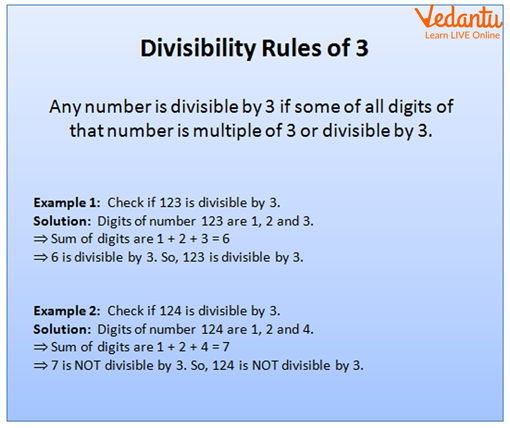




Step-by-Step Guide: How to Test if a Number Is Divisible
The division is used much more often than you realise. When splitting food or money with friends, or even when slicing a pizza, division is used. Divisibility rules in Maths are a collection of specific criteria that apply to a number to determine whether or not it is divisible by a specified number. Some well-known divisibility rules are for numbers ranging from 2 to 10.
The rules allow us to find factors and multiples of numbers without having to conduct lengthy divisions. By following the divisibility rule formula, a person can determine if a number is divisible by another integer. In this article, we will learn about the divisibility rules with examples.
Division Rule of Integers
In Mathematics, division rules help to identify whether a number is divisible by another number instead of using the actual method of division. If one number is totally divisible by another, the quotient is a whole number, and the remainder is always zero. If a number is not completely divided by any other number, such numbers have a remainder other than zero or nonzero. Now let’s see the divisibility rules with examples one by one.
Division Rule For 2
If you have a number with the last digit as 0 or an even number, it is divisible by 2. For example, the number 20 ends with a zero. When half of a number is split, the outcome is 10, which is an even number.
Example: Check whether the number 257746 is divisible by 2.
Ans: Since the number ends with 6, which is even. Hence the number 257746 is divisible by 2.
Division Rule For 3
If the total of the digits of a number is divisible by three, then the number is divisible by three. Students must be able to divide to apply this strategy, but verifying smaller numbers is easier than large ones. To get more clarity for the divisiblity rule for 3, see the division rules chart given below.

Division Rules Chart for 3
Example: Check whether the number 168 is divisible by 3.
Ans:
$1+6+8=15$
$\Rightarrow \dfrac{15}{3}=5$
As a result, 168 is divisible by 3.
Division Rule for 4
If a number's last two digits are divisible by four, then the whole number is divisible by 4.
Example: Check whether the number 7516 is divisible by 4.
Ans: Since the number 7516 has the last two digits 16, divisible by 4. Hence the number 7516 is divisible by 4.
Division Rule For 5
When the last digit of a number is 0 or 5, the value can be split evenly by 5. As a result, 5, 10, 15, 20, 25, and so on can all be divided by 5.
Example: Check whether the number 160 is divisible by 5.
Ans: Since the last digit of the number 160 is 0. So, 160 is divisible by 5.
Division Rule For 6
Numbers divisible by 6 can also be split by 3 and 2. Students should test the number using both rules for 3 and 2. If the number passes both criteria, it can be divided by 6. If it fails even one test, it cannot pass.
Example: Check whether the number 306 is divisible by 6.
Ans: Since 308 ends in an even digit, it is divisible by two. However, 3 + 0 + 6 Equals 9, which can be divided evenly by 3. As a result, 306 is divisible by 6.
Division Rule For 8
A large number is divisible by 8 if the last three digits are either divisible by 8 or are 000.
Example: Check whether the number 9864 is divisible by 8.
Ans: Since the last three digits are divisible by 8 (i.e. $864 \div 8=108$ ). Hence the number 864 is divisible by 8.
Division Rule For 9
Since 9 can be divided by 3. Therefore, the divisibility rule for 9 is the same as for 3. If the sum of a number's digits is divisible by 9, then the whole number is also divisible.
Example: check whether the following number is divisible by 9 or not.
$549=5+4+9=18$
$\Rightarrow \dfrac{18}{2}=9$
Ans: As a result, 549 is divisible by 9.
Division Rule For 10
If the last digit is 0, the number can be evenly divided by ten.
Example: check whether the no. 1650 is divisible by 10 or not?
Ans: However,1650 ends with 0, which can be divided evenly by 10. As a result, 1650 is divisible by 10.
Solved Example

Example Time
Q 1. Find out if 2415 is divisible by 7 using the divisibility rule of 7.
Ans: Applying the 7-division rule to the number 2415 will reveal whether it is or is not divisible by 7.
Multiply the unit’s digit (5) by 2. The answer is 10.
Take the remainder of the number, 241, and subtract the product (10) from it. (241 - 10 = 231)
We are unsure if 231 is a multiple of 7. Consequently, let's return to step 1 and enter 231 there.
Multiply the unit’s digit (1) by 2. The answer is 2.
Take that number out of the total, which is 23. (23 - 2 = 21)
Since 21 is completely divisible by 7, we can say that 2415 is divisible by 7.
Practice Problems
Q 1. Check whether the number 198 is divisible by 8.
Ans: Not Divisible.
Q 2. Check whether the number 6273 is divisible by 3.
Ans: Yes.
Summary
The divisibility rule enables us to determine whether or not the number is divisible by another number. When two numbers can be divided evenly, the quotient is always a whole number, and the remainder is always zero. If a number is not completely divided by another number, the remainder is not zero or non-zero. It is the easiest and quickest way to solve division.
There are various rules to check divisibility. Some well-known divisibility rules are for numbers between 2 and 10. Hope this article will help you solve the division questions quickly by using the rule we learned.
FAQs on Essential Divisibility Rules for Numbers
1. What is the divisibility rule for prime numbers?
Prime numbers are the ones having just two factors: one and itself, which means they can be divided by either 1 or themselves only. For example, 7 is a prime number as it is divided only by 1 and itself.
On the other hand, 8 can be divided by 1, 2, 4, and 8 evenly. The number 1 is not a prime number as it only has a single factor, while prime numbers have two factors. Prime numbers are always whole numbers that are always greater than one.
2. What are the divisibility rules for 12 and 13?
A number that is divisible by both 3 and 4 is divisible by 12. For example, 168 whose sum of digits is 15, so it is divisible by 3. In the number 168, the last two digits are 68, so the number is divisible by 4. Since the number 168 is divisible by 3 as well as 4, it is also divisible by 12.
In a number when the four times of the last digit is added to the remaining number and the process is repeated until we get a two-digit number, the number is divisible by 13.
3. What are the divisibility rules for co-prime numbers?
The pair of numbers having 1 as a common factor is known as co-prime numbers. If any number is divisible by the co-primes, it is also divisible by the product of the co-primes. For example, both 4 and 5 are divisors of 80 and they are co-primes as well since they have 1 as their common factor; therefore, 80 can also be divided by the product of the co-primes which is 20.
4. Find the factor for the number 1346 by going through each divisibility rule.
To find the factor for the number 1346, we use divisibility rules:
Since the last digit of 1346 is even, it is divisible by 2.
The sum of all digits of 1346 is 14, which indicates that it is not divisible by 3.
The last two digits of 1346 are 46 which is not divisible by 4, therefore the number is also not divisible by 4.
The last digit in the number 1346 neither has a 0 nor a 5, therefore it is also not divisible by 5 and 10 at the same time.
The number 1346 is not divisible by 3, hence it is also not divisible by 6.
The number 1346 is not divisible by 7 as well since 1346 - 15 = 1334.
The last three numbers of 1346 are not divisible by 8 as well.
Since the sum of all digits is 14, the number is not divisible by 9.
Therefore, the factor for 1346 is 2.
5. What is the prime factorization method?
When a number is factored into only prime numbers, the factorization is known as the prime factorization method. The number which is not prime has only one prime factorization. The factorization of every number is either its equivalent factorization that involves one or more non-primes or its prime factorization. For example, the factorizations of 20 are as follows:
20 = 20 x 1
20 = 2 x 10
20 = 2 x 5 x 2
20 = 5 x 2
20 = 4 x 5
6. What is the relationship between the dividend, divisor, quotient, and remainder?
The relationship between the dividend, divisor, quotient, and remainder—one of the key components in the division—is illustrated by the dividend divisor quotient remainder formula. A number is divided into equal parts in the division process, leaving a remainder if the number cannot be further divided. The division rule formula is one of the four basic arithmetic operations. A given value's division formula can be stated as, $\dfrac{\text { Dividend}}{\text { Divisor }}=\text { Quotient }$
7. How many divisibility rules are there?
Generally, we have divisibility rules from 1 to 20. But if we could identify the pattern of multiples of numbers, we could create more divisibility tests. For example, the divisibility rule of 21 states that a number must be divisible by both 3 and 7. It is because 21 is a multiple of two prime numbers, 3 and 7, so all the multiples of 21 will have 3 and 7 as their common factors.
3. What is the use of divisibility rules?
In Maths, divisibility tests are important to learn as it helps us to ease out our calculations where we have to do multiplication and division. We can quickly identify whether a particular number is divisible by another number or not by applying divisibility rules.

















